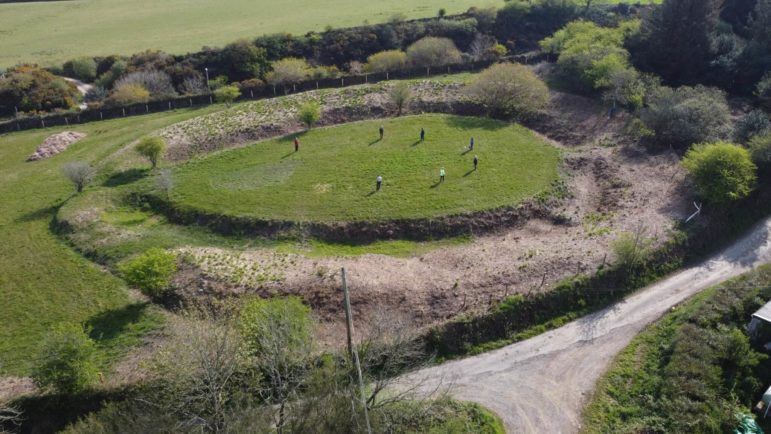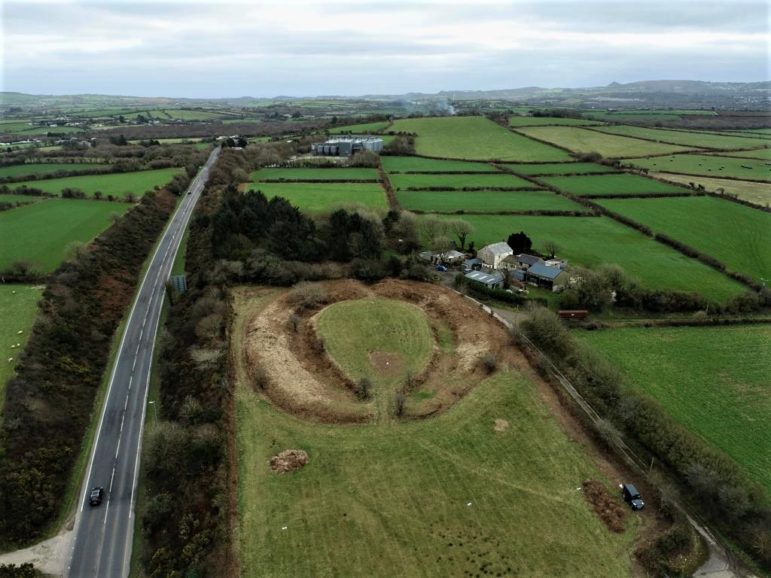BODMIN, Cornwall, England – The site of an ancient stone circle has been discovered in Cornwall. The discovery was made at Castilly Henge, a prehistoric burial site, by Historic England (HE) and the Cornwall Archaeology Unit.
Castilly neolithic henge which has recently been found to contain a stone circle #castillyhenge #Archaeology #neolithic #Cornwall #castilly pic.twitter.com/RdkuE4Kh9L
— Cornwalllitwithlight (@Cornwalllitwit1) May 24, 2022
The site was developed around 3,000 to 2500 BCE, defined by a bank and ditch which give it the appearance of an amphitheatre: in Medieval times the site was apparently used as a “playing place,” for people to put on plays or hold other events, and during the English Civil War may also have been utilised as a cache for weapons. But more recently the site had become covered in vegetation, which obscured any underlying features.

Historic England volunteers marking the stone circle during the site’s first modern archaeological survey [Photo Credit: Cornwall Archeological Unit/PA Historic England]
Once this was cleared by volunteers, taking over 100 hours of work to do so, HE was able to conduct detailed topographic and geophysical surveys of the area, and this was when the stones were discovered. The site itself has been known to be a henge since excavations in the 1950s and 60s.
Ann Preston-Jones, project officer for at-risk heritage sites with Historic England, says: “The research at Castilly Henge has given us a deeper understanding of the complexity of this site and its importance to Cornish history over thousands of years. It will help us make decisions about the way the monument is managed and presented, so that it can be enjoyed by generations to come.”
Seven pits in the site have been disclosed by ground scans: the stones are no longer in situ, but the holes show where they would have stood, in a horseshoe configuration. Scientists say that the stones may have originally stood in a full circle, but the north side of the site was impossible to investigate thoroughly. Some stones were removed, but it seems that others were shoved down into their pits.

Aerial view of Castilly Henge after volunteers cleared the area [Photo Credit: Cornwall Archeological Unit/PA Historic England]
The site is on farmland, and now that it has been cleared, will be grazed by the local farmer’s animals, thus keeping it clear.
You might think that the name “Castilly Henge” would be a bit of a clue, but for the uninitiated, a “henge” does not refer to a ring of stones or a stone monument. English Heritage define a henge as:
“ a prehistoric circular or oval earthen enclosure, dating from around 3000 BCE to 2000 BCE, during the Neolithic (also known as the new Stone Age) and early Bronze Age.”
Key features are a ring-shaped bank on the outside, and a ring-shaped ditch on the inside, which is why Castilly is named as a henge, since it has this structure. They are rare: there are fewer than 100 henges across Britain and Ireland, although it is probable that there were once more.
Cornwall itself has many ancient monuments, from fogous to quoits, stone circles and standing stones. Bodmin moor and the moors of Penwith are full of them, including the Stripple Stones, Lanyon Quoit, and Men-an-Tol, the Merry Maidens and the Hurlers.
The region is also full of Bronze Age settlements: though now perceived as remote in terms of the British Isles, the area was comparatively well populated in ancient times.
In later eras, holy wells such as St. Piran’s Well, St. Mawes Well and St. Cubert’s Well came into being. The Neolithic history of Cornwall begins at the end of the last Ice Age, with the upland moors being settled first.
Around 3000 BCE, stone chambers were constructed, probably for communal burials. However, the acidic soil of the Cornish moors tends to destroy organic remains and thus finds are not as common as they are in other areas.
A previously unknown stone circle has been revealed at Castilly Henge near Bodmin, Cornwall. 🟢
— Historic England (@HistoricEngland) May 19, 2022
The discovery follows new archaeological surveys carried out to better understand the site. ➡️ https://t.co/947tSfh14p
🧑🤝🧑 Volunteers mark out the position of the stone circle. pic.twitter.com/L02B9YTCNA
At some time around 2500 BCE, it seems likely that another wave of settlers arrived from the Continent: they built rather different graves, found in the west of the region and in the Scilly Isles, which resemble those found in Brittany.
It is not known who these people worshipped. The later Celtic settlers of the area were also pre-literate, so archaeologists and anthropologists must piece their theories together from what remains. Nowadays, however, Pagans are the third-largest faith group in Cornwall, who join in traditional folklore-based celebrations such as the Padstow Obby Oss in addition to the wheel of the year festivities undertaken in contemporary Paganism, many of which are held at ancient sites.
TWH canvassed the Pagan community for their views on the newly discovered site:
Byron Arthur Clark, Graduate Teaching Assistant at UBC Anthropology Department told TWH, “…of the pre-Celtic peoples who may have built this we know very very little. We do not know what language they spoke, we have no real information about their ethnic identity, and we have only the vaguest outline of their spiritual beliefs via gravesites and the henges they left behind.
“At best I’d say we can say that some of their structures were repurposed by later people’s, such as the Celtic speaking people’s, who certainly would have been Pagan as we understand it historically. But the people who built these may have had their own monotheistic faith for all we know. It’s really a coin flip as to what their beliefs entailed and how far they would have resembled that of the Celts (or other recognizably “Pagan” peoples) in any way.”
The Wild Hunt is not responsible for links to external content.
To join a conversation on this post:
Visit our The Wild Hunt subreddit! Point your favorite browser to https://www.reddit.com/r/The_Wild_Hunt_News/, then click “JOIN”. Make sure to click the bell, too, to be notified of new articles posted to our subreddit.